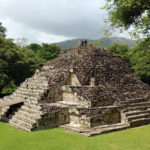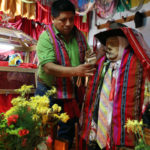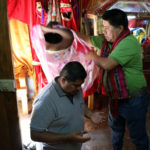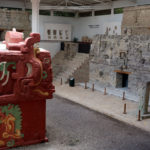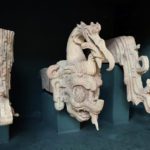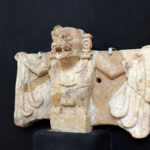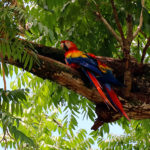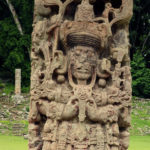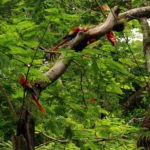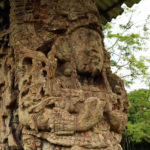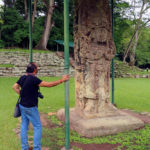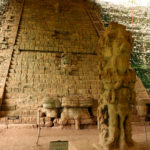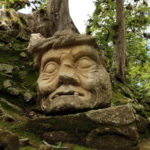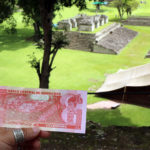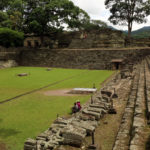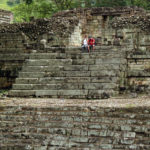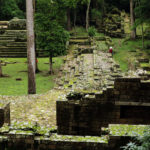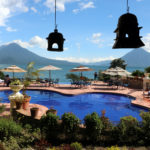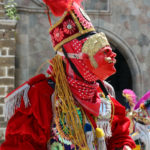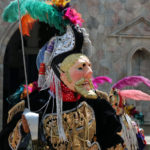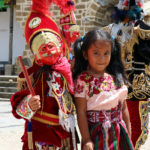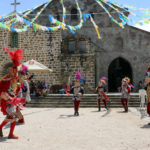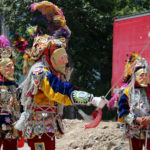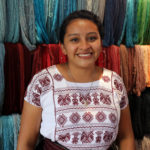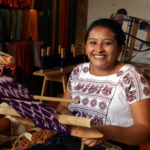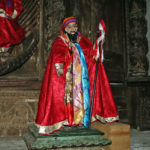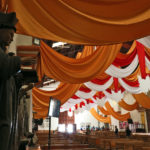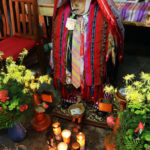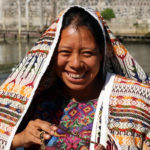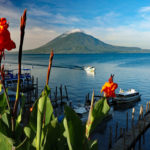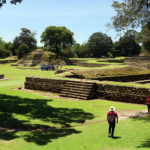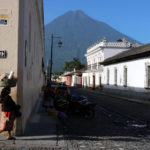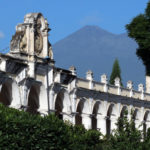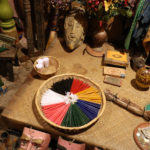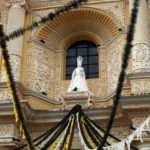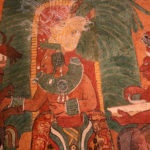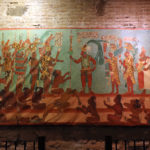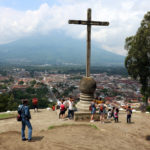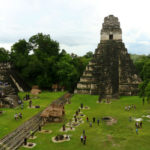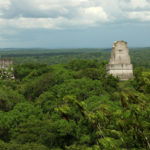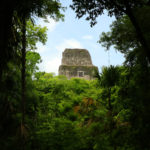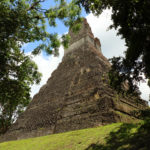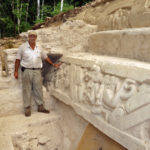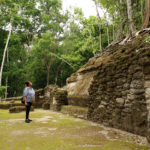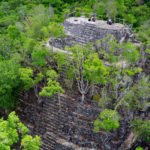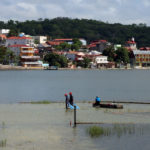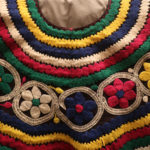“I shall be telling this with a sigh
Somewhere ages and ages hence:
Two roads diverged in a wood and I –
I took the one less traveled by,
And that has made all the difference.”
–Walt Whitman
Sitting atop the largest pyramid in the world in northern Guatemala’s ancient Maya city, El Mirador, I tried to imagine how the city below looked nearly 2500 years ago. Standing nearby, the site’s principal archaeologist, Dr. Richard Hansen, explained how this had been one of the greatest cities of the ancient world, filled with dozens of grand palaces, pyramids and temples painted in vivid red, green, yellow and white hues, and adorned with elaborately carved images. Now mostly covered by forest, the ten-square-mile city also boasted the world’s-first “highway system” with hundreds of miles of raised causeways, up to 150 feet wide, sealed with a thick layer of white limestone plaster. I couldn’t help wondering how it was possible for such an advanced civilization to have disappeared so suddenly and completely?
To unravel this and other Maya mysteries, I joined a tour called “The Lost Kingdoms of the Mayas,” led by two remarkable guides from Bella Guatemala Travel, Jose Antonio and Emilio. For ten days our small group explored colonial cities, lakes, jungles, and Maya museums and ruins scattered across Guatemala and western Honduras. Jose Antonio shared his boundless enthusiasm for Maya archaeology, frequently reminding us that “archaeology turns mystery into history.”
We were all surprised to learn that while Europe lay mired in the Dark Ages, the Maya kingdoms spread across Central America were flourishing to the extent that their level of architecture, art, science and writing placed the Maya culture among the most advanced in the world. Remarkably, many centuries-old Maya traditions still flourish throughout Guatemala, as I witnessed repeatedly in archaeological sites where “spiritual guides” or shamans performed traditional ceremonies around fire rings in order to bring better health, wealth or happiness to their clients.
Our guides pointed out that Guatemala is bordered by Mexico, Belize, Honduras and El Salvador, and depends on agriculture, textiles and tourism to sustain its sixteen million people. In the past, many travelers considered Guatemala as an unsafe place to visit: following its independence from Spain in 1821, Guatemala endured significant political tumult, culminating in a vicious civil war from 1960 to 1999. But the country has recovered from those dark days and I felt completely safe and grateful to be among the growing number of visitors from around the world.
Of the many experiences we had on this comprehensive tour, these are the highlights I’ll remember most:
- The helicopter ride to El Mirador took us over the largest remaining rainforest in Central America, saving us a three-day hike, which was the only other option. I felt more like Indiana Jones than a tourist as we spent hours with Dr. Hansen, touring us around the mysterious, tree-covered site.
- Tikal, which is both a UNESCO World Heritage site and a national park, offered a mix of wildlife (coatis, monkeys and various birds) and impressive ruins. Our guide, Jose Antonio, explained that at its peak, from 200 to 900 AD, Tikal was one of the largest and most powerful Maya cities. As we walked through the vast complex of pyramids and palaces, I was struck by how little most of us knew about the impressive Maya civilization.
- Las Lagunas Boutique Hotel, located on a lake in northern Guatemala, provided us with luxurious cottages perched over the water, each with a private, indoor Jacuzzi and large windows for viewing the tranquil scene. We requested a tour of the hotel owner’s private Maya collection which contained artifacts that stunned even Dr. Hansen.
- In Antigua, a city renowned for its Spanish colonial architecture, we started our tour at a former Dominican convent that now offers an upscale hotel, restaurant, Maya museum and large gardens, followed by a visit to a nearby coffee plantation, La Azotea, that not only offered samples of locally-grown coffee, but also housed an intriguing art and music cultural museum. That evening we sampled Guatemala’s Zacapa rum, rated as the finest rum in the world, at the classy Casa del Ron in the middle of town.
- Lake Atitlan sits in a giant crater in the southwest highlands, ringed by eighteen villages and three towering, cone-shaped volcanoes. We stayed in Panajachel, a rather non-descript town filled with small tourist shops, but across the lake, in the small town of Santiago, we had an unforgettable experience observing a team of spiritual guides giving offerings to the sacred image of the Mayan diety, Maximon. In the Catholic church nearby, the symbols and decorative neck scarves adorning several religious statues demonstrated how traditional Maya beliefs have been blended with modern Christianity.
- Perhaps my favorite Maya site was Copan, located in western Honduras, two hours from the Guatemala border. Now a UNESCO World Heritage Site, Copan had once been a dominant kingdom in the region. I felt awed by its elaborate sculptures and impressive palaces, temples, ball courts, stele, and pyramids that covered the verdant valley. Hidden near the park’s exit, the Copan museum was my favorite museum of the trip, a place not to be missed—we entered it via a long tunnel that led to a large, open display area dominated by a full-scale replica of a Maya temple painted in the same colors (red, yellow, green and white) as the sacred scarlet macaws that still soar among the ruins today.
I came away from this trip knowing that we had been fortunate to see and learn so much about both the ancient Maya civilization and modern-day Guatemala. Over the years I had heard consistent praise about Guatemala from other travelers, and now I felt grateful to have finally been able to traverse this “road less traveled” with the help of Bella Guatemala Travel.
Doug Hansen is a travel writer and photographer in Carlsbad, CA. See more photos and articles at www.HansenTravel.org or Instagram @doug6636………………………………………………………………………………………………………………………………………….
IF YOU GO:Bella Guatemala Travel: 818-669-8435; Info@BellaGuatemalaTravel.com; www.BellaGuatemalaTravel.com. If you want charming & knowledgeable guides who are fluent in English to help you explore Guatemala’s fascinating ancient and modern Maya culture, while staying at luxury hotels and meeting with world-renowned Maya scholars, this tour is for you.
Lodging: Las Lagunas Boutique Hotel; reservations@laslagunashotel.com; http://www.laslagunashotel.com. Spend two nights here if possible, enjoying your over-the-water cottage, private Jacuzzi, and gorgeous lakeside infinity swimming pool.Rum tasting: La Casa del Ron, #22, 03001, 4a Calle Oriente #39, Antigua; +502 7832 4477.

